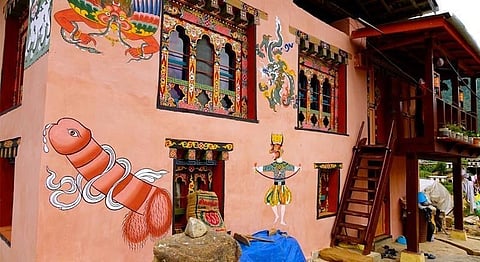
- HOMEGROWN WORLD
- #HGCREATORS
- #HGEXPLORE
- #HGVOICES
- #HGSHOP
- CAREERS
- ABOUT US
- CONTACT US

Way out on the North Eastern border of India lies Bhutan, the quaint little Buddhist country nestled in the hills. A place where you’d imagine swirling wisps of clouds gently caress the mighty Himalayas, surrounded by expanses of greenery and hilly terrain. A land known for its scenic beauty, ancient culture and traditions - oh yes, and even its phallic art.
Bhutan is home to relics with a rich cultural heritage and legacy as well as walls adorning murals of erect penises; some with eyes, ribbons, one features a dragon and a few even ejaculating. While an unsolicited dick pic makes our eyes roll with disdain, here phallic imagery and artefacts find place in people’s houses, public institutions, temples and are even used in rituals and ceremonies, more so in the Punakha District. Foreign tourists are rather startled with the ease with which people here carry on their daily routines, children play in the streets and vendors sell their wares with penises literally everywhere – on doors and windowsills, they decorate signboards and even exist as souvenirs, all in a variety of sizes. Drawing dicks may have been a problem for Jonah Hill’s character in the movie Superbad but in Bhutan, it’s hard to believe that they actually have a spiritual context.
But where and how did this adoration of the one-eyed wonder worm begin? Their comfort lies rooted in no sexual innuendoes or penis worship but rather in an ode of devotion to an eccentric 15th century Tibetan monk and Lama, Drukpa Kunley.
Known as the ‘divine madman’, Drukpa Kunley was originally from Tibet and wanted to spread his teachings to a new land. The legend goes something like this; he shot an arrow into the air and then embarked on a journey to locate the spot where it landed. That landing spot was in Punakha, and it is where he established a temple. Today, it is Chime Lhakhang, also known as Chimi Lhakhang, a small Buddhist monastery and fertility shrine which still houses the bow and arrow.
Another story suggests that it was built on the spot where Drukpa Kunley defeated a demoness called Loro Deum that resided in the Dochula Pass area and harassed people. He chased her down and found her, having transformed herself, as a dog to evade him and avoid detection. He vanquished her with his ‘flaming thunderbolt of wisdom’ and buried her under a black chorten. The name itself, Chime Lhakhang, nods to this tale as in Dzongkha ‘Chi’ means dog and ‘me’ meaning no literally translates to ‘no dog’.
It was his outlandish ways and unconventional teachings that drew people to him. He shook up the traditional Buddhist method of learning and horrified orthodox society with his philandering, wine-drunk wit, risqué poetry and humour.
And what exactly did he do that was so crazy? Well, one story states that when he was gifted a sacred thread to tie around his neck, he used it instead to accessorise his schlong stating that it would “bring him luck with the ladies” – probably why you’ll find murals of penises with ribbons in the region – and on another occasion it is said he urinated on an ancient scroll.
The ‘Mad Saint’ upset the establishment with his ‘thunderbolt of wisdom’ with antics that were borderline bizarre, with several sexual overtones. He wanted to put an end to the social conventions – provoking people, encouraging them to set aside their manners and stifling thought that, he believed, is only limiting then when it comes to finding their own path to enlightenment.
Couples from all over the land flock to Chime Lhakhang today, either to be blessed with fertility in the form of taps on the head with a wooden phallus that was allegedly brought down by Drukpa Kunley from Tibet, or those that return to offer thanks for the born child and conduct naming ceremonies. While there are those in the country that dismiss these stories as the folklore of an antiquated past, a lot of Bhutanese people keep some sort of penis imagery in or outside their home to ward off evil spirits, gossip and bring good luck.
Whatever the lore may be, Punakha continues to draw the curiosity of the world and it isn’t hard (no pun intended) to see why. Maybe Drukpa Kunley was really onto something - after all, they are among the happiest people in the world.
If you enjoyed this article we suggest you read:
